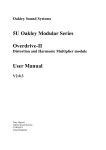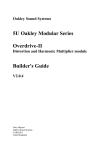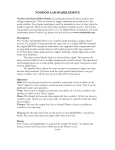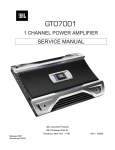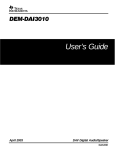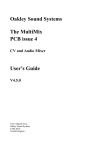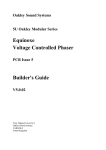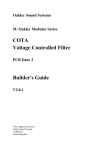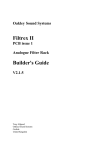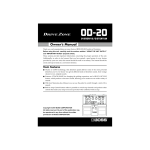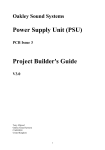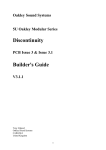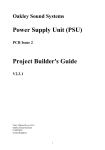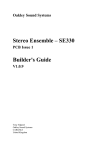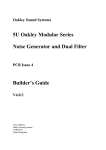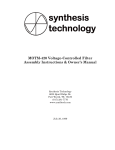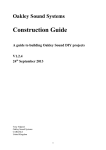Download 5U Oakley Modular Series Overdrive User Manual and Builder`s Guide
Transcript
Oakley Sound Systems 5U Oakley Modular Series Overdrive Soft and hard clipping module User Manual and Builder's Guide V1.4.1 Tony Allgood B.Eng Oakley Sound Systems CARLISLE United Kingdom 2 Introduction This is the Project User Manual and Builder's Guide for the issue 1 Overdrive 5U module from Oakley Sound. This document contains a basic summary of its operation, a how it works section, a full parts list for the components needed to populate the board and some basic testing methods. For general information regarding where to get parts and suggested part numbers please see our useful Parts Guide at the project webpage or http://www.oakleysound.com/parts.pdf. For general information on how to build our modules, including circuit board population, mounting front panel components and making up board interconnects please see our Construction Guide at the project webpage or http://www.oakleysound.com/construct.pdf. The 5U Overdrive Module This is a simple but very effective waveform modifier module. It has two basic modes selected by a switch. Hard clipping is a hard edged distortion type effect useful for grunging up your signal. Soft clipping is a more subtle effect and produces a clean sounding overdriven amp sound. Three front panel pots control the sound. 'Gain' controls the overall gain of the 'pre-amplifier' stage and essentially determines the level of overdrive or distortion. The 'timbre' or tone control is an effective EQ control that affects the frequency response of the effected output. The 'mix out' or balance pot is essentially a wet/dry mix control that allows you to add only as much of the effect as you want. Voltage control is determined not within this unit, but as part of the signal chain placed before this module. Using a VCA to control the signal level that is fed into this unit will determine the strength of the overdrive or distortion. Using a VCF to alter the timbre of the signal fed to this module will control the overall harmonic level far more than using a filter alone. In fact, hard sync type sounds can be easily obtained by simply sweeping the filter's cut-off frequency. 3 Using the Oakley Overdrive – A Personal Perspective. Since this module has been available I have read many comments from users regarding its usefulness. Probably more than any other Oakley module it has produced the largest split of people who either loved, and still love it, and those that were profoundly disappointed with it. Truthfully, I can't say I particularly enjoy receiving negative comments but in some ways it is those negative comments that make one work harder to perfect any design. The problem is that with some things it simply boils down to personal taste. I think the Oakley Overdrive is one such thing – it either produces a sound that you like or it doesn't. Furthermore, since it does very little other than overdrive the input signal it is a bit of a one trick pony. If you like the trick then all is well, if not, it's time to move on. Nevertheless, it may be that the module is somewhat misunderstood. After all, the most common criticism with the module is that it doesn't actually do much. In this perspective I wish to argue the case for its defence. It actually does do a lot but it all depends on what sort of signal you are putting into it. The Oakley Overdrive, in its overdrive mode, is quite simply a derivative of a famous overdrive guitar pedal. This highly popular pedal has been around for many years and it is widely copied. Several years ago I made up my own stomp box version of it. Initially, driven from a 9V battery, then later from a 9V wallwart, I pretty much slavishly copied the original's circuit. Later still I modified the main gain stage and then added a hard clipping circuit (the distortion mode). I used this for many years with my SH-101 and SH-1 and it's pretty much the plaintive solo sound on my own music albums. The Oakley Overdrive module uses very similar circuitry to this prototype pedal. The basic circuit topology remained the same but I changed the design to allow it to run from a split power supply. I was careful to recreate the same voltage limits as in the 9V design as I was keen to replicate the op-amp's saturated output characteristics. I also tailored the gain stages to be more responsive to the levels seen in a modular synthesiser. The key thing about using this module is to not use any signal that has a high harmonic content. Indeed, inserting a raw square wave into it will do nothing. Overdriving a square wave simply produces another square wave. The tone control may have an effect but it probably won't lead to an increase in distortion. Inserting a sawtooth will also have little effect. In fact it is more likely in this case that the sound is dulled – the sawtooth waveform would be turned into something more square wave like and therefore less harmonics would result. None of these things are perhaps what we would look for in a distortion unit. Therefore to get the best out of the unit, when playing just single notes at one time, it is important that the input signal should have a relatively low number of harmonics. Where the Overdrive shines is when you use the module after a filter - especially one set to relatively high resonance. The filter will select certain harmonics and the overdrive module will accentuate these still further. So much so that the harmonic's frequency will dominate over the fundamental. The effect is similar to the classic Moog Prodigy sync sound when sweeping the frequency of a slaved VCO. And overdriving a simple one VCO - one VCF arrangement is used frequently with the TB303 to give those rasping squealing acid lines. However, it can be 4 also used more subtly on more mellow filter sweeps with the overdrive adding gentle overtones to a solo synthesiser lead. The actual input level is very important too. The Overdrive module will produce much more strident results when the input level approaches 5V peak. If the input signal is too weak then the resultant overdriven effect will be much less. This means it is possible to get voltage controlled overdrive effects if you use a VCA in front of the module. It is traditional to have the distortion after the final VCA. In a fixed architecture synthesiser this is generally the only way you can do it. But I find that using it between the VCF and the final VCA gives me right sounds for solo work. The VCF will naturally vary the signal level as the cut-off changes and having the VCA last will ensure that any additional hiss produced by the high gain amplifier in the overdrive module will be only heard along with the signal and therefore drowned out. More complex sounds, such as chords, drum loops and so on, will be far more effected than simple notes too. The more varying frequencies that are present in the input signal the more distorted the output will appear. Generally speaking if you are after subtle overdriven effects it is best to keep the input signal to just a few harmonically related notes. The Overdrive PCB I have provided space for the three main control pots on the PCB. If you use the specified Spectrol pots and matching brackets, the PCB can be held firmly to the panel without any additional mounting procedures. The pot spacing is 1.625” and is the same as the vertical spacing on the MOTM modular synthesiser. The design requires plus and minus 15V supplies, but it will run quite happily on +/-12V too. The power supply should be adequately regulated. The current consumption is about 15mA for each rail. Power is routed onto the PCB by a four way 0.156” Molex type connector. You could, of course, wire up the board by soldering on wires directly. The four pins are +15V, ground, earth/panel ground, -15V. The earth connection allows you to connect the metal front panel to the power supply’s ground without it sharing the modules’ ground line. More about this later. The PCB has four mounting holes for M3 bolts, one near each corner. These are not required if you are using our specially made pot brackets. 5 Components For general information regarding where to get parts and suggested part numbers please see our useful Parts Guide at the project webpage or http://www.oakleysound.com/parts.pdf. Some special considerations for this project The op amps are any high quality dual audio op-amp. The design has been tested with OP275G, JRC4558, TL072 and OPA2134A. All parts work very well, but there are slight audible differences in the part selected for U3. I will ask the builder to experiment here, but I did like the results when using the OP275G in both U3 and U4. Use a socket for U3 and you can swap chip types with ease. The diodes are just ordinary 1N4148 silicon diodes. However, there is some scope in playing around with the diode types in positions D5 and D6, and positions D7 and 8. Indeed, some useful results can be obtained in using germanium diodes, like the OA91 or 1N34A, in positions D6 and D8. This makes for asymmetrical distortion but I have not found the results to be especially different in synthesiser use. You could also use two diodes in series for one of the places, eg. D6 could be replaced by one 1N4148 and a 1N34A in series. U1 and U2 are three terminal regulators. They are listed as 100mA devices and are +5V and -5V respectively. They are very common devices – but be careful you don't get the surface mount versions. You need the plastic TO-92 ones and not the SOP-8 package. You will also need a double pole double throw switch. These are sometimes called DPDT or 2PCO (two pole changeover). This type of switch has two sets of contacts inside, each one has a wiper that can move between two other contacts. These sorts of switches have six solder tags. Watch out for sizes, there are many different types of toggle switches and some of them can be very big and will clash with the PCB if using the suggested panel design. I use miniature flat toggle types made by Apem and sold by Farnell. 6 5U Overdrive Parts List The components are grouped into values, the order of the component names is of no particular consequence. A quick note on European part descriptions. R is shorthand for ohm. K is shorthand for kiloohm. For capacitors: 1uF = 1000nF. To prevent loss of the small ‘.’as the decimal point, a convention of inserting the unit in its place is used. eg. 4R7 is a 4.7 ohm, 4K7 is a 4700 ohm resistor, 6n8 is a 6.8 nF capacitor. Resistors 5% 0.25W or better 47R 220R 1K 1K5 10K 15K 27K 33K 100K 360K R6, R7 R5 R2, R13, R15 R10 R1 R11 R4 R3, R8, R16 R9, R14 R12 Capacitors 10pF, low K ceramic 47pF low-K ceramic 47nF polyester 150nF polyester 220nF polyester 470nF polyester 100nF multilayer ceramic 2u2, 63V electrolytic C21, C5 C8 C22 C19 C4, C9 C2, C3, C18 C10, C11, C12, C13, C14, C15 C1, C6, C7, C16, C17, C20 Discrete Semiconductors 1N4148 silicon diode D1, D2, D3, D4, D5, D6, D7, D8 Integrated Circuits 78L05 5V 100mA regulator 79L05 -5V 100mA regulator OP275G dual op-amp U1 U2 U3, U4 Onboard Pots All pots Spectrol 248 series or BI TT P260P. 7 50K Lin 100K Log 10K Lin BALANCE GAIN TONE Miscellaneous Leaded Ferrite beads Double pole changeover switch Molex or MTA 4 way header L1, L2 S1 PWR 1/4” sockets Two off mounted off board You'll also need solder, two lots of about 75cm of insulated multistrand hook up wire, each of a different colour, and a couple of cable ties. You may well want to use sockets for the ICs. I would recommend low profile turned pin types as these are the most reliable. You need two 8-pin DIL sockets. 8 Circuit Description This module is probably one of the simplest we make, and indeed, if you have already looked at other overdrive circuits you may well recognise some of the features used in this particular design. The module is powered in the conventional way from a split rail of +/-15V. This comes in to the module via the 0.156” MTA connector PWR. L1 and L2 in conjunction with C12 and C13 provide high frequency filtering and decoupling. They essentially act to keep the power supply as free from noise as possible. The main overdrive and distortion circuitry is actually run from a lower +/-5V supply. This is generated in the usual, if somewhat overkill, fashion of using two three terminal regulators, U1 and U2. These generate a very stable quiet low noise split 5V rail which the more sensitive parts of the overdrive circuitry can run. R6 and C6, and their negative equivalent, provide additional filtering and isolation from main 15V rails. D1 to D4 provide discharge paths during power up and down cycles which could potentially harm the ICs on the circuit. The input signal is firstly attenuated by an inverting amplifier block based around U4A (pins 2, 3 and 1). This circuit reduces the input signal to around a quarter and provides the following sections with a constant source impedance. Without this part of the circuit, the overdrive core and the balance pot may affect the source signal's integrity and cause unwanted distortion if you were using the Overdrive module in parallel with another module. U4A's output is then split, one side going to the balance pot which will provide the 'dry' signal, and the other side going into the overdrive's core circuitry. The core of the overdrive module is based around the same circuit as used in many guitar overdrive foot pedals. To my knowledge this type of design first appeared in the Ibanez Tubescreamer TS-808 pedal, but it also appears in other commercial pedals including the Boss OD-1 and SD-1, and other later Ibanez pedals. The TS-808 pedal has become something like the equivalent of the TB-303 in the guitar world and the original green units sell for a great deal of money. However, the basic circuit is actually quite simple and it is one that I have used in various home made pedals for some time. There are great deal of DIY TS-808 clones out there and many of them will talk about the huge differences in using different diodes and types op-amps. I found that, for synthesiser use at least, the actual sonic differences due to the actual devices used are not quite as obvious as internet lore has decreed. However, I will leave it to the builder to experiment here and I am sure that the Oakley-Synths list would be a great place to discuss your findings. The key in the basic TS overdrive circuit is the usage of a standard non-inverting high gain opamp stage, U3A, with two diodes in reverse parallel with the resistative feedback path. These diodes act to limit the voltage across the feedback resistor. These are shown in the schematic as D5 and D6. They can be switched in and out of the circuit with S1A, the overdrive and distortion selection switch. Because they act upon the feedback voltage and not the output signal directly they do not behave as a traditional clipping circuit. In the latter any signal is simply limited to a set maximum or minimum voltage. The TS circuit is more subtle than that. 9 The gain of the op-amp non-inverting amplifier is set by the resistances within the feedback loop, but because of the way it works this is always more than or equal to one, ie.0dB. That is, the output level is never less than the input. The exception to this is at very high frequencies when the op-amp reaches its operating limits. Ignoring the diodes for now, U3A has its passband gain set to a minimum of 11, via R2 and R1. The gain pot allows this gain to increase still further by increasing the feedback resistance. With the gain pot turned up full the maximum passband gain of the op-amp without the diodes is 111. A diode will behave in such a way as to limit the positive voltage across it to no more than 0.6V. It does this by effectively changing its resistance depending on the voltage it has across it. Two diodes connected in reverse parallel, head to tail, tail to head, will seek to limit the voltage across them to +/-0.6V. D5 and D6 are connected to act like this. So as the output level of U3A rises, either by turning up the gain pot or by applying a bigger input signal, so does the feedback voltage. Once the feedback voltage gets to beyond +0.6V or below -0.6V, the diodes start to conduct and the rise in output level is tempered. However, the gain of U3A cannot fall to below unity, so the diodes only appear to act on the amplified signal. Thus what we get at the output is a clipped amplified signal plus the original signal superimposed on it. This is the TS sound and it has great tonal characteristics. I ought to add that a great part of the overdrive sound is also due to frequency shaping. C4 rolls off the gain at lower frequencies. C8 and the slew rate of the op-amp act to curtail high frequency components. It is these that set the width of passband, that area in which the opamp acts as an amplifier. In addition C18 will effectively block any DC signals to the amplifier. The Oakley Overdrive has a major difference that the original TS doesn't have. We can switch out the diodes completely and allow U3A to become an unlimited high gain amplifier. But of course, everything has limits and this time the output is limited by the supply voltage to U3A. This is set by the +/-5V power supply and this causes the output to clip at around +4V for positive excursions and -4V for the negative. The op-amp cannot produce any output signal higher than this. However, when S1 switches out the two diodes in the feedback path, it also switches in, via S1B, two more reverse parallel diodes, D7 and D8. In conjunction with current limiter R10, these two diodes act as a traditional diode clipper and truncate the voltage across them to around +/-0.6V. This is the 'distortion' mode and two different types of clipping are now possible in this mode. The diode clipping is apparent with high input signals with low gain, or low input signals with high gain. However, at high gains with medium to high input levels, both the op-amp output limiting and diode clipping work together to give you a more pronounced effect. Immediately after the diode clipping circuit there is some additional high frequency filtering, based around the actions of R10 and C22. This low pass filter reduces the harshness and gives a rounded tone to the sound. Coupled with the bass end roll-off of C4, the overall frequency response over the distortion sections is focussed on the mid-range part of the audio spectrum. The tone control is based around the classic TS and SD-1 design and is built around U3B. Its a simple circuit that works well in practice and produces enough tonal variation to be very 10 useful. At the lowest setting of the Tone pot, called 'timbre' on the suggested front panel, C9 acts in conjunction with R10 to produce a single pole low pass filter. At the high end of the tone pot's travel, C9 now mostly acts in conjunction with the feedback resistor R13 and R5 and produces a shelving high pass filter. This boosts high frequencies and produces a much sharper sound. This is particularly apparent in the 'distortion' mode since this part of the circuit produces much more higher harmonics due to the more severe clipping affect. The output of the tone control stage is fed to the other end of the balance pot, called 'mix out' on the front panel. This is a simple arrangement that lets the user apportion the mix of distorted and straight-through signal. The relatively high impedance output of the wiper of balance pot would not be able to drive any other external modules direct, so it is buffered and amplified by a simple inverting amplifier U4B. R15 provides protection and stability for the output signal. 11 Connections The power socket is 0.156” 4-way header in common with rest of the Oakley and MOTM modules. Friction lock types are recommended. Power Pin number +15V Module 0V Earth/Screen -15V 1 2 3 4 The PN1 and PN2 pads on the PCB has been provided to allow the ground tags of the jack sockets to be connected to the power supply ground without using the modules 0V supply. Earth loops cannot occur through patch leads this way, although screening is maintained. Of course, this can only work if all your modules follow this principle. You have two sockets and one double pole switch to wire up. The sockets are easy enough, but the switch wiring is a little tricky so you need to be careful. Let's have a look at the sockets first. If you have used Switchcraft 112 sockets you will see that they have three connections. One is the earth tag, one the bevelled edge. One is the signal tag which will be connected to the tip of the jack plug when it is inserted, its marked with a small T. The third tag is the normalised tag, or NC (normally closed) tag, and is marked T/S presumably standing for 'tip/switched'. The NC tag is internally connected to the signal tag when a jack is not connected. This connection is automatically broken when you insert a jack. In the Overdrive module we will be using the NC lug on the INPUT socket to short out the input line to ground when there is no jack inserted. Connect, with a piece of insulated wire, the following tags on each socket to the respective pad on the PCB: Socket Name Tag type PCB pad name INPUT INPUT INPUT OUTPUT OUTPUT Signal NC Earth Signal Earth IN GND PN1 OUT PN2 Well, that's the sockets wired up, lets have a go at the switch. The first thing you need to do is to make up some twisted pairs of wires. These will be used to connect each pole of the switch to the board. A twisted pair is exactly that, two wires twisted together to form a simple cable. The best way to make a twisted pair is to use a hand drill or slow moving battery powered drill. Take two one metre lengths of coloured insulated multistrand wire and tie them to something fixed like a door handle. Did he say door handle? I did, but you can be professional 12 and use a bench vice if you wish. Straighten the wire out and push the two free ends into a chuck of the drill. Now hold the drill so that the wire is horizontal and fairly taught. Both wires should be the same length, if not, make sure they are. Now let the drill slow spin and the wires will twist together neatly. Don't make it too tight, but don't put too few turns on it either. Practice makes perfect as they say. You should be warned that when you release the wire, it tends to curl up a bit, but this is fine and you should have a nice twisted pair to work with. You need to cut your new cable into two small pieces that will allow the switch to be connected to the board. If you are using the suggested front panel, then you will be fitting your switch so that the toggle moves up and down. Lay the module flat so that the front panel is facing away from you and the board is facing upwards. Your fitted switch will have two sets of three contacts, and these will now be lying horizontally. The wiper contacts are the two middle pins, one above the other. Let us wire the bottom set of contacts first. These are to be connected to the pads on the board named S1A. Solder both wires of one of the twisted pairs to the pad S1A. There are two pads, so that each wire is connected to its own solder pad. The other end of your pair should now be soldered to the switch. But you have three contacts and only two wires in your pair. Solder one of the wire ends, it doesn't matter which, to the left hand tag of the bottom row of contacts. Then solder the remaining one to the middle tag. Now let us wire the top set of contacts. These are to be connected to the pads on the board named S1B. Solder both wires of the other twisted pair to the pad S1B. Again, there are two pads, so that each wire is connected to its own solder pad. The other end of this twisted pair should now be soldered to the switch. This time we are using a different part of the switch. So solder one of the wire ends, again it doesn't matter which, to the middle tag of the top row of contacts. Then solder the remaining one to the right hand tag. You can now use a couple of cable ties to hold the two twisted pairs together for neatness. 13 Testing, testing, 1, 2, 3... Apply power to the unit making sure you are applying the power correctly. Check that no device is running hot. Any sign of smoke or strange smells turn off the power immediately and recheck the polarity of the power supply, and the direction of the ICs in their sockets and the polarity of the electrolytic capacitors. Assuming everything is OK so far, it is time to apply an audio input. The easiest way to test the Overdrive module is to use a triangle wave output from a VCO. Start with the TIMBRE pot set to its middle position, the gain pot at its lowest and the MIX OUT pot to DRY. Set the switch to OVERDRIVE. If you listen to the output signal you should hear just the triangle wave as it would be if it were coming straight out of the VCO. Be careful to check your listening levels as the output signal will get louder in the next section. Now rotate the MIX OUT pot and you should hear the sound becoming brighter. Now turn up the GAIN and listen as the sound gets both louder and brighter still. Change the switch to DISTORTION and the sound gets louder still and more harsh. There will a small click in the audio output as the switch is moved, this is normal behaviour. Check that the GAIN pot still has an effect on the sound with the switch in this position. Alter the TIMBRE pot and you'll hear that this acts as a simple tone control – boosting treble signals at its maximum level. You'll probably also notice that with a high gain setting that the volume increases quite dramatically too as considerably more of the higher harmonics are let through. If all this happens, the chances are that you have a working module. 14 Final Comments If you have any problems with the module, an excellent source of support is the Oakley Sound Forum at Muffwiggler.com. Paul Darlow and I are on this group, as well as many other users and builders of Oakley modules. If you can't get your project to work, then Oakley Sound Systems are able to offer a 'get you working' service. If you wish to take up this service please e-mail me, Tony Allgood, at my contact e-mail address found on the website. I can service either fully populated PCBs or whole modules. You will be charged for all postage costs, any parts used and my time at 25GBP per hour. Most faults can be found and fixed within one hour, and I normally return modules within a week. The minimum charge is 25GBP plus return postage costs. If you have a comment about this user guide, or have a found a mistake in it, then please do let me know. But please do not contact me or Paul Darlow directly with questions about sourcing components or general fault finding. Honestly, we would love to help but we do not have the time to help everyone individually by e-mail. Last but not least, can I say a big thank you to all of you who helped and inspired me. Thanks especially to all those nice people on the Muffwiggler's forum and Synth-diy and Analogue Heaven mailing lists. Tony Allgood at Oakley Sound Cumbria, UK © October 2009 – updated April 2012 No part of this document may be copied by whatever means without my permission. 15
















